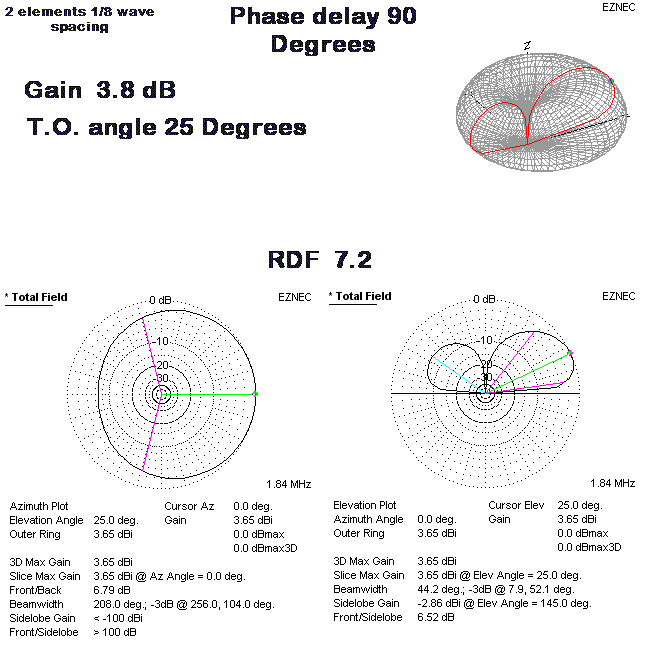Low Band Receiving Antenna
Comparisons![]()
How I compare Rx antennas. It would definitely be up for debate as to how to compare low band receiving antennas at any given location. There are many factors involved such as available real estate, complexity, cost, portability, front to back ratio, and arguably the one that is most important to me, something W8JI calls RDF (relative directivity factor). RDF is the difference between the maximum forward gain in the direction of interest and the average gain in all directions of an antenna. Thanks to W7EL and his EZNEC program it is relatively easy to compare different configurations of antennas for their RDF. In my case I don't care how much real estate it takes for antennas as I live in farming country with at least 100 acres around me. I do have to take the antennas down in the spring because the fields are actively used for farming. I don't care too much about front to back ratio as there are not a lot of loud stations at my location that I cannot separate with 20 db front to back. I am blessed to have an electronics shop as well as a welding/machine shop so cost of fabrication is not near as much a factor as it might be for some. So mostly I have found that it boils down to RDF and how can I get more while making it somewhat portable. I have found that my antennas when working properly do indeed perform with a signal to noise ratio that follows the comparison chart below. Tom W8JI makes similar comments on his outstanding website.
Comparison Chart of Different Rx antennas. Gain, front to back, and RDF computed at 20 degrees elevation over average ground and at 1.850 Mhz. Because of the same elevation angle for all antennas, some will not appear as they would at maximum gain.
This site is protected against hot linking due to abuse so if you have trouble downloading the Eznec files by direct click contact k7tjr at arrl.net
![]() Download Eznec file
Download Eznec file
![]() Azimuth plot
Azimuth plot
Link to K7TJR 8 Element Receiving Array uses Hi impedance amplifiers and shortened verticals.
See www.hizantennas.com for parts and supplies for Hi-Z antennas
Animated 2 element array comparison. Two Hi-z elements spaced 1/8 wavelength with varying phase delay.

There are many pages on the web describing the K9AY loop. More discussion of it here is not necessary. With the exception that my observation is many people build this antenna and fiddle with the termination resistor to try for the ultimate. Some even make them remote control. My tests show that changing the termination from 330 ohms to 550 ohms only varies the RDF by .11 out of 7.2. Hardly worth ever worrying about for copying any DX unless you need the Front to back rejection for local noise.
Larry W7IUV has a rather complete description on how to build the Flag antenna . The only comment I have about that antenna is that it seems really ground independent for those with really poor grounds and it is rotate able with great front to back for notching interference. Combine that with 7.4 RDF and it seems better than a K9AY.
Jose Carlos has a complete discussion of his Waller flag antenna at N4IS to me the jury is still out on this one as it has such low output and I wonder about noise figure. Guess I will have to build one.
Tom W8JI has lots of coverage on Beverages on www.w8ji.com